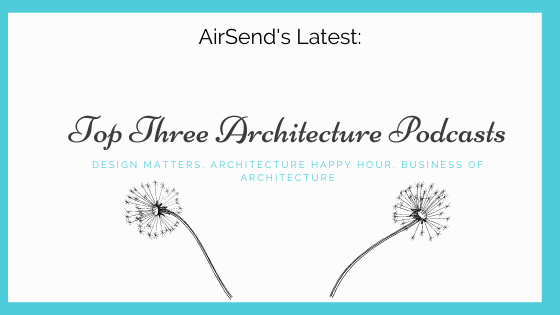
We bet you didn’t think that we would do a podcast on architecture, but here it is! After scouring the internet, we came up with three of our favorite architecture podcast. While we are on the podcast talk, dive into our other podcast suggestions! Now that introductions are out of the way, let’s talk about architecture!
Architecture is both the process and the product of planning, designing, and constructing buildings or any other structures. Architectural works, in the material form of buildings, are often perceived as cultural symbols and as works of art.
From prolific styles to renowned architects, architecture is by far one of the most captivating fields of study. It is a field of study that we feel is particularly underappreciated, and because of this, we felt that it was time for someone to show some affection. For more information on architecture, we highly suggest researching other podcasts. Let’s begin.
Design Matters
With a fun UI (user interface) design and a plethora of categories, this podcast has it all. Host/ founder and author of six books, Debbie Millman is the first and longest-running podcast about design.
With over 300 interviews from design luminaries and cultural commentators, Design Matters has garnered over 5 million downloads, along with a Cooper Hewitt National Design Award. Since this post is focused on architecture, we looked at episodes that were relative to that, however, we do suggest looking at Millman’s other episodes.
James Biber

James Biber is an architect that focuses on multi-disciplinary environments. According to the interview with Millman, Biber’s “work centers on a belief that architecture is an expression of identity that is inseparable from its language of form and tectonics” (2012). This belief results in the idea that “architecture ties closely to its context; whether physical, cultural, or metaphorical” (2012).
Throughout the episode, Millman discusses with Biber on the essence of art and architecture. They begin with Biber’s unusual fascination with the Waffle House. According to Biber, Waffle House has the largest sign to store ratio.
Additionally, they have everything for everybody. What is also fascinating to Biber, is the visual vernacular of the signage. Essentially the signage represents a model of simplicity and efficiency. An important concept to note, that is also often repeated throughout the episode is the mass market.
The mass-market relative to architecture is huge. If one were to slightly redesign any mass marker, such as McDonalds or Waffle House, the impact would be phenomenal. The mass-market + slight change = global market. How is this equation relative to architecture? Biber explains that architects avoid normalcy because it represents generic things that they are in fact trying to change. In other words, from an architects’ perspective, there is a need to change the world, and to change the world, one of the approaches is the mass-market industry.
“Construction is still an extremely analog activity, it is science, art, craft.”
Biber 2012
Also interesting to note is that Biber makes the argument that architecture is synonymous to biography. Architecture, from Biber’s point of view, is that is it brain made- it is impossible to design something without it being personal, historical, etc. Architecture is always burdened with a set of meaning, therefore it is a brain made, and therefore a biography.
Biber’s work has been recognized by the AIA, AIGA, SEGD and other professional design organizations, and has been published in The New York Times, Architectural Record, The Wall Street Journal, Architect, Blueprint, Wallpaper, Dwell, Metropolitan Home, New York Magazine and the design press internationally.
The Architecture Happy Hour
Yes, we said Happy Hour. We loved the title too. With a classy suave intro, The Architecture Happy Hour is an informal and entertaining podcast that started in 2009 hosted by hpd architecture + interiors, Laura Davis and Holly Hall.
“From the very beginning, we wanted the podcast to feel like you were sitting down with friends to chat about architecture and home design. And if you happen to have a cocktail in your hand, even better.”
Davis.
Their podcasts include but are not limited to:
- home design
- home improvement
- kitchen and bathroom design
- architecture
- interior design
- updating from traditional to contemporary
- how to select a contractor
- working with an architect
- becoming an architect
The episode we will be focusing on is “Episode 87: New Year Resolutions in Your Home.”
Episode 87:New Year Resolutions in Your Home
The question Davis and Hall propose is that if your home could make New Year’s resolutions, what would they be? Throughout the episode, Davis and Hall discuss several ways to make your home more healthy, better organized, and budget-smart. From sorting to maintenance, to even home designing tips, David and Hall cover it all.
One of the tips to having a healthier is purging. Purge your junk drawer, closets, kitchen, etc. Purging your items will allow you to see the space available, and perhaps further projects to improve on, such as cabinetry, painted walls, flooring, countertops, etc. Purging allows for the impactful benefits of feeling cleaner, efficient, and productive.
Holly and Davis say to start from the floor to doors, cabinets, and then ceiling. Additionally, go room-to-room, and prioritize the list. Lastly, create a calendar. Creating a calendar to input a goal for each month is a great way to improve your house. What are some New Year Resolutions for your home?
Business of Architecture
Enoch Sears is the host and founder of the Business of Architecture. Sears started this practice as a resource for firm owners. Further, his mission has been to discover and share strategies, tactics, and tools needed to run a successful practice.
Note that Business of Architecture does dive into the realm of said study, however, it also encompasses the idea of creating a successful enterprise with architecture. Sears’s methodology is adopting the “ArchitectCEO” mindset. The ArchitectCEO takes ultimate responsibility for his or her results and success. Think like a CEO, not an architect.
To show how this method works, we chose “Episode 309: Architect Creates Illustration Brand with Rajiv Fernandez.”
Episode 309: Architect Creates Illustration Brand with Rajiv Fernandez.

Rajiv Hernandez is a trained and licensed architect. He currently is the CEO of his illustration company, Lil’ ICon. As a graduate of the Colombia School of Architecture, Fernandez believed he had more to offer to the world.
After the 2016 election, Fernandez took a risk to jump in unfamiliar territory, illustration, to create a voice. The majority of the illustrations Fernandez creates deals with political and social commentary. His mission is to inspire people to talk and connect his illustrations with architecture.
As a freelance entrepreneur, Fernandez realized that he had to become resourceful and hustle his way to his dream. The way Fernandez hustled was by asking around, “hey are you looking for an illustrator or an architect to do work?”
Further, Fernandez explains that transitioning from an architecture firm to freelance gave him the choice to choose his own projects. Doing so allows him to choose smaller clients. Additionally, by becoming a freelance entrepreneur/architect, it became easier to get architecture projects.
A piece of key advice that Fernandez gives, especially for those wanting to do more than just architecture, is to spread your business/mission by word of mouth and referrals from partners.
Additionally, having the power to say no to certain projects balances out your creative outlet and work. Lastly, according to Fernandez, having a dedicated office space allows for a rigid schedule and mode of productivity.
Summation
For those seeking to do more with architecture, understand that conquering your aspirations can be a slow grind. However, if you are like Fernandez, who is basically a hardcore hustler, anything is possible.
These are our top favorite architecture podcasts. Our purpose with this blog post: eliminate the notion that there is only one form of architecture. With the insightful and refreshing point-of-view, we can be certain that there are in fact a variety of ways to use architecture. One is the classic design way, the second, using it in interior designs, and lastly as a form of enterprise. Of course, there are other ways to implement the architecture, but we will leave you to find that out.
AirSend helps architects, interior designers, and creatives create a versatile digital workspace to share files, send messages, and complete tasks. See how AirSend can help you.